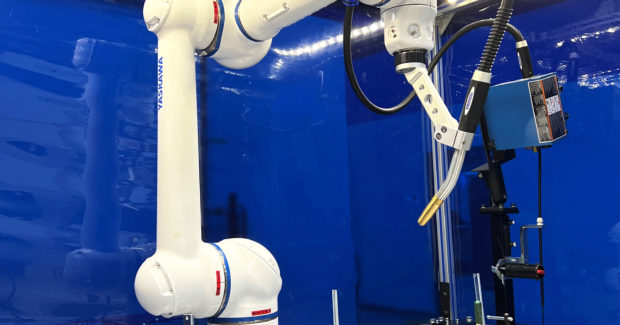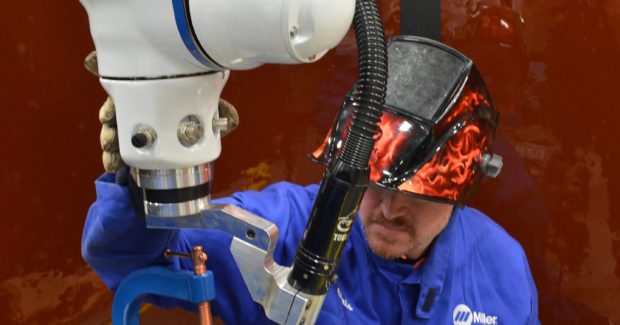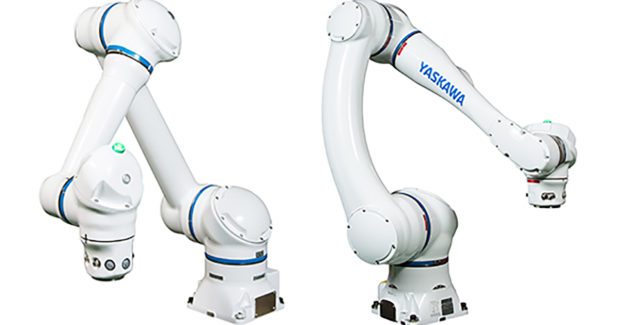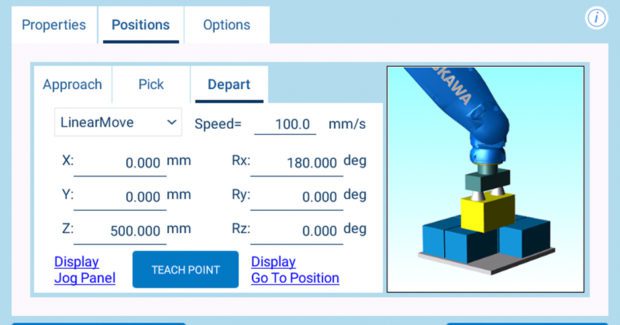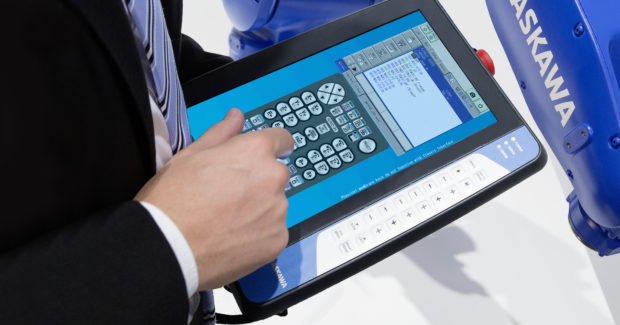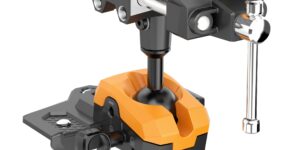The Impact of Collaborative Robots
Flexible easy-to-use cobots with high-performance capability are positively impacting the industrial future.
Posted: August 23, 2022
Once a straightforward decision toward conventional robot implementation, the robot selection process is rapidly evolving. From traditional industrial robots to collaborative robot arms, a range of more affordable yet highly capable robots and their peripherals is enabling manufacturers to create interactive, space-saving floorplans that optimize productivity and supply chain management.
Designed for speed, strength and repeatability, conventional industrial robots continue to impact a wide range of dull, dirty, dangerous and, sometimes, disliked jobs. Various arc and spot-welding robots enable a growing list of joining methods, and more recently, an array of higher payload models with increased arm reaches and robust tooling are addressing today’s trends toward electric vehicle battery production. Applications for assembly, coating, cutting, finishing, sawing and more are also expertly supported by many traditional robot arms.
Intended to work autonomously, or apart from humans, industrial robots will continue to be the “go to” method for many manufacturing tasks. However, decision makers looking to optimize floorspace or maximize other production conditions, such as workforce availability, are seeing valuable potential in collaborative robot usage. Expected to grow at a compound annual growth rate (CAGR) of 43.4% by 20271, the cobot market is poised to address growing demand, and robot suppliers are following suit by providing industrial-strength collaborative robots that can quickly and safely tackle tough challenges in high-mix, low-volume production environments.
High Performance Expectations
The evolution of safety standards, easy programming options and flexible end-of-arm tooling (EOAT) for collaborative models continues to build confidence in company leaders, prompting many to implement flexible cobots. So much so, that collaborative robots are the fastest growing segment of the robotics industry2, with a clear path for expansion. Whether coexisting in the same general workspace, collaborating on the same workpiece, or synchronized to cooperate somewhere in-between, sensor technology, software algorithms and other peripherals work together, meeting a variety of end user expectations.
Today’s floorspace restraints and pressing time-to-market demands dictate the use of flexible yet efficient automation that facilitates safe human-robot interaction. From smooth surfaces to pinch-less designs, end users are looking for robots that are constructed to work safely with or alongside humans. Keep in mind, a collaborative robot in name is not adequate to deem an application as safe. A thorough risk assessment of the entire robotic system including the robot, workpiece, work area and EOAT must be performed. If any of these critical areas fails to meet specified safety standards, the application does not qualify, and it cannot be approved without proper risk mitigation.
To reach the level of safety required, manufacturers often employ a variety of intelligent technologies to enable the proper mode(s) of collaboration. Whether by built-in Power and Force Limiting (PFL) technology, Hand Guiding, Safety Monitored Stop, or Speed and Separation Monitoring, a variety of technologies can be used to enable safe human-robot interaction.
Along with increased safety, robot users now anticipate collaborative systems to 1) feature space-efficient designs with reduced guarding to optimize floorspace, 2) utilize intuitive accessories for greater ease of use and efficiency, and 3) provide impeccable flexibility for fast changeover and quick implementation of a robot system. All of this works together to provide a fluid user experience capable of reducing robot downtime, improving equipment uptime, decreasing costs and boosting employee morale.
Clever System Designs
With respect to collaborative system selection for a specific task, manufacturers should carefully analyze operations to choose the best cobot for the job. From payload capacity, maximum reach and construction (cast aluminum vs. extruded tube), to overall footprints, ingress protection (IP) ratings, food-grade grease options and more, there are key robot features that should not be overlooked. Failing to do so will most likely result in lackluster return on investment (ROI) and low cobot confidence.
With this, user-friendly cobots with intuitive graphic interfaces are also ideal to implement, facilitating extremely easy programming for fast deployment and redeployment on demand. The Smart Pendant, for example, uses patented built-in technology that makes the robot programmer the frame of reference and moves the robot relative to the user. This Smart Frame feature eliminates the need for conventional coordinate frames (X, Y, Z) and enables quick implementation of a robot system, especially for basic assembly, handling, injection molding, inspection, machine tending, and pick and place tasks.
Taking all of this into consideration should not only optimize ROI, but also, it can steer decision makers to the proper solution. Interestingly, many manufacturers end up with what is being termed a “collaborative hybrid.” Typically employing multiple operating modes to ensure safety and relying on third-party technology to detect human proximity, these robust systems provide the best of both worlds — easily shifting between collaborative speed in PFL mode or full speed in industrial mode (based on risk assessment and requirements).
Along with easy programming, these durable hybrids typically offer a 10-to-30-kg payload capacity and an impressive maximum reach for greater application flexibility. Collaborative robots, such as the HC20, are also often equipped with a common ISO tool mounting flange and electrical connections for fast and simple deployment, easily adapting to production fluctuations.
Meshing well with third-party solutions, including integrated vision and perception tools to accommodate objects that may vary in height or to eliminate part feeders or fixtures, is also a mark of these highly versatile robot models. Depending on the application, software development kits (SDKs) can even be used to combine multiple components for automating a specific process into a single convenient file. Programming extension kits, like Smart Pattern, are extremely helpful for repetitive stacking, unstacking, case packing and machine loading/unloading tasks, generating code for specific patterns while incorporating concepts for frame setup, tool condition file definitions and job I/O.
Proven Shop Staple
Moving forward, manufacturers will embrace the collaborative concept, utilizing extremely robust cobots to tackle a variety of tasks. Projected to hold a majority of the market growth, collaborative robots for material handling and general assembly continue to positively impact nearly every industry3. At the same time, cobots with IP67 ratings are quickly emerging as the industry standard in tight spaces where accommodating machine tending cutting fluids, weld spatter and other manufacturing particles is necessary.
With collaborative welding in mind, highly flexible cobots with hand-guided teaching are well-suited to supplement manual welding or for rolling-up to large, heavy workpieces. Modular weld table designs with arc flash and fume mitigation are extremely helpful, bolstering current workforce conditions while enabling consistent weld quality. Assisting the latter, pendant applications, such as the Universal Weldcom Interface (UWI), help users gain easy control of any weld process or parameter, including voltage, amperage and wire feed speed.
To help manufacturers scale up or down and align with production goals, the concept of Robotics as a Service (RaaS) is also making a difference. This on-demand concept allows decision makers to harness robotic automation for a range of applications in a cost-effective way that optimizes their bottom line.
All things considered, the utilization of collaborative robotic systems for welding and other common applications — including cobot use for autonomous mobile robots (AMRs) — will continue to emerge and permeate the industrial landscape. While companies of all sizes that find a cohesive balance between human workers and collaborative technologies should expect productivity gains, medium- to small-sized manufacturers may see the greatest transformation. Either way, flexible easy-to-use cobots with high-performance capability will further evolve and augment production, positively impacting the industrial future.
End Notes
1 Collaborative Robot Market by Component, MarketsandMarkets, 2021
2 The Market for Cobots is Expected to Triple, New Heights Research, 2022
3 Collaborative Robots Market, Future Market Insights, 2022
Subscribe to learn the latest in manufacturing.


